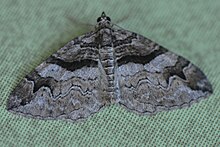| Pareulype berberata | |
|---|---|

| |
| Scientific classification | |
| Domain: | Eukaryota |
| Kingdom: | Animalia |
| Phylum: | Arthropoda |
| Class: | Insecta |
| Order: | Lepidoptera |
| Family: | Geometridae |
| Genus: | Pareulype |
| Species: | P. berberata |
| Binomial name | |
| Pareulype berberata (Denis & Schiffermüller, 1775) | |
| Synonyms | |
List
| |
Pareulype berberata, the barberry carpet moth, is a moth of the family Geometridae. The species was first described by Austrian lepidopterists, Michael Denis and Ignaz Schiffermüller in 1775. The moth is found in Africa, Asia and Europe.
Subspecies
Subspecies include:
- Pareulype berberata berberata
- Pareulype berberata maindroni Herbulot, 1977
- Pareulype berberata sineliturata Culot, 1919
Distribution
This species can be found in most of Europe (Austria, Balearic Islands, Belgium, British Islands, Bulgaria, Central European Russia, Croatia, Czech Republic, Denmark, France, Germany, Hungary, Italy, Latvia, Lithuania, Luxembourg, Poland, Romania, Slovakia, Slovenia, Spain, Sweden, Switzerland, The Netherlands and Ukraine), in the Near East and North Africa.
Habitat

These moths are silvicolous and they mainly occur in deciduous, mixed and coniferous forest, clearings and warm slopes, at an elevation up to 1,000–1,500 metres (3,300–4,900 ft) above sea level.
Description
Pareulype berberata has a wingspan of 27–32 mm. Antennae are filiform. Forewings show greyish ground colour, with dark brown and ash brown trasversal wavy bands. Hindwings are pale and unmarked. The larvae are brown, usually with a wavy white line on the sides.
Biology

There are two generations per year, as this species is bivoltine. Adults emerge from May to June and again in August. The second generation pupate in the ground approximately at the end of September. The pupa overwinters. The larvae feed on barberry shrubs (Berberis) from July to October.
Human relevance
Barberry bushes, on which the larva exclusively feed, were mostly eliminated by farmers in the United Kingdom because they can act as a host to a rust fungus that also infects wheat. Rust resistant wheat was developed, but not before the barberry shrub disappeared from most of Britain. The barberry carpet moth declined in parallel with the decline of the bushes until only around ten colonies were left in England.
One of the Back from the Brink conservation projects, some barberry carpet moths were reared in captivity and after the barberry shrub was reintroduced to 169 sites, captive moths were released and are now found at several locations throughout southern and central England. The programme was managed by the Barberry Highways Group, including Chester Zoo, Dudley Zoo, British Waterways, Drayton Manor Theme Park, West Leeds Country Park and Butterfly Conservation.
References
- ^ "Pareulype berberata (Denis & Schiffermüller, 1775)". Fauna Europaea. Retrieved 4 July 2021.
- "Pareulype berberata Schiffermüller, 1775". Catalogue of Life. Retrieved 4 July 2021.
- Axel Hausmann, Jaan Viidalepp Larentinae I
- ^ Kimber, Ian. "Barberry Carpet Pareulype berberata ([Denis & Schiffermüller], 1775)". UMmoths. Retrieved 4 July 2021.
- "How to Save a Bug's Life". The Independent. Retrieved 4 July 2021.
- "Barberry well done". Butterfly. No. 137. Butterfly Conservation. Summer 2021. p. 10.
- "Creature Features: A Dream job for Hannah Follows". Birmingham Mail. 12 June 2012. Retrieved 4 July 2021.
External links
| Taxon identifiers | |
|---|---|
| Pareulype berberata |
|